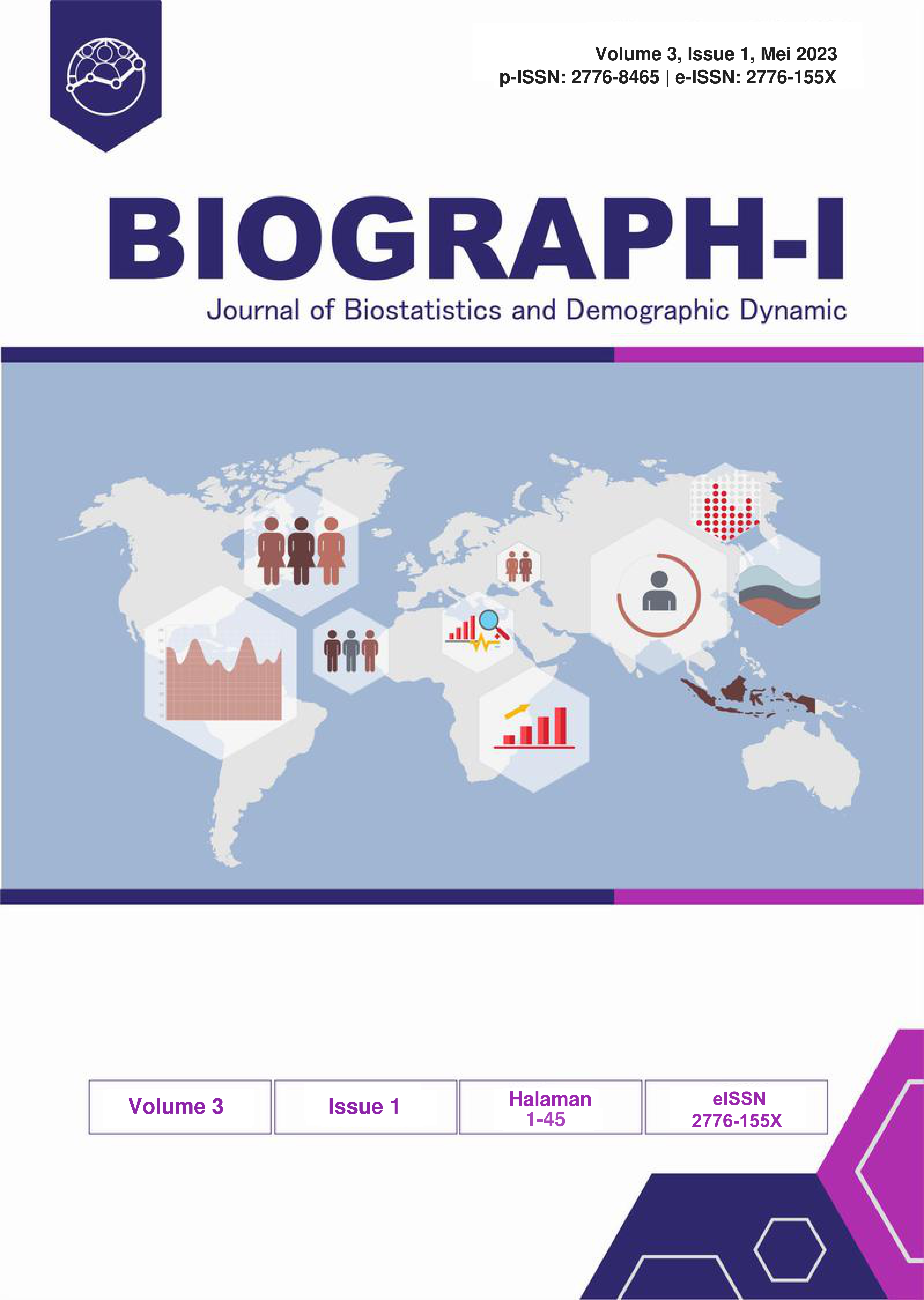Faktor-Faktor yang Berhubungan dengan Pemeriksaan Triple Eliminasi pada Ibu Hamil di Puskesmas Cibeber Kota Cimahi Tahun 2022
DOI:
https://doi.org/10.19184/biograph-i.v3i1.38017Keywords:
Ibu hamil, Motivasi, Paparan informasi, Pemeriksaan triple eliminasi, Pengetahuan, Persepsi hambatanAbstract
Program Pencegahan Penularan dari Ibu ke Anak (PPIA) diintegrasikan sebagai upaya eliminasi HIV, Sifilis, dan Hepatitis B (Triple Eliminasi). Cakupan triple eliminasi pada ibu hamil tahun 2021 di kota Cimahi belum mencapai target Nasional, yaitu pemeriksaan HIV sebesar 37,15%, Hepatitis B sebesar 55,26%, dan Sifilis sebesar 35,20%. Tujuan penelitian ini adalah untuk menganalisis faktor-faktor yang berhubungan dengan pemeriksaan triple eliminasi pada ibu hamil di Puskesmas Cibeber Kota Cimahi Tahun 2022. Penelitian ini merupakan penelitian kuantitatif dengan pendekatan cross-sectional. Dalam penelitian ini digunakan sampel sebanyak 86 ibu hamil, pengambilan sampel menggunakan simple random sampling. Analisis data bivariat menggunakan uji chi-square. Sebagian besar ibu hamil tidak melakukan pemeriksaan triple eliminasi (55,8%), hampir setengah ibu hamil memiliki pengetahuan kurang (40,7%), hampir setengah ibu hamil memiliki motivasi lemah (47,7%), hampir setengah ibu hamil mendapat informasi mengenai triple eliminasi dari media (44,2%), dan hampir setengah ibu hamil terdapat hambatan terhadap persepsi (34,9%). Terdapat hubungan antara pengetahuan (p-value = 0,004), motivasi (p-value = 0,002), paparan informasi (p-value = 0,000), dan persepsi hambatan (p-value = 0,017) dengan pemeriksaan triple eliminasi. Terdapat hubungan antara pengetahuan, motivasi, paparan informasi, dan persepsi hambatan tentang triple eliminasi dengan pemeriksaan triple eliminasi di Puskesmas Cibeber Kota Cimahi tahun 2022. Oleh karena itu, perlu diberikan konseling mendalam pada ibu hamil mengenai pemeriksaan triple eliminasi untuk meningkatkan cakupan pemeriksaan triple eliminasi di Puskesmas.
Downloads
References
2. WHO. The Triple Elimination of Mother-to-Child Transmission of HIV, Hepatitis B and Syphilis in Asia and the Pacific, 2018–2030. Worls Heal Organ West Pacific Reg. 2018;2018–30.
3. Intan K. Faktor penyebab kejadian kongenital di RSUP DR Hasan Sadikin Kota Bandung Tahun 2018 Karlina Intan Sekolah Tinggi Ilmu Kesehatan Rajawali Bandung. J Kesehat Rajawali. 2020;10(2):36–51.
4. Fatimah M, Respati SH, Pamungkasari EP. Determinants of Pregnant Women Participation on Triple Elimination of HIV, Syphilis, and Hepatitis B, in Semarang. J Heal Promot Behav. 2020;
5. Verasita P, Budihastuti UR, Murti B. Contextual Effect of Community Health Service on the Use of Triple Elimination Service. J Matern Child Heal. 2021;
6. Wenny DM, Wijayanti Y, Hakimi M. Faktor yang memengaruhi partisipasi ibu hamil melakukan skrining HIV di puskesmas Yogyakarta. Ber Kedokt Masy. 2016;
7. Katamba PS, Mukunya D, Kwesiga D, Nankabirwa V. Prenatal hepatitis B screening and associated factors in a high prevalence district of Lira, northern Uganda: A community based cross sectional study. BMC Public Health. 2019;
8. Alemu YM, Ambaw F, Wilder-Smith A. Utilization of HIV testing services among pregnant mothers in low income primary care settings in northern Ethiopia: A cross sectional study. BMC Pregnancy Childbirth. 2017;
9. Ngakan Putu Anom Harjana, Sally Nita, Meirinda Sebayang, Oldri Sherli Mukuan, Asti Setiawati Widihastuti. Determinant of service utilization for triple elimination of mother-to-child transmission of HIV, syphilis, and hepatitis B among women living with HIV during COVID-19 pandemic in Indonesia. Intisari Sains Medis. 2022;13(2):452–9.
10. Wulandari A, Palupi R, Siwi Y, Retnaningtyas E, Billy MM. Factors Affecting Mother Of Doing A Triple Elimination At Uptd Of Palla Public Health Center , North Wewewa Sub- District , Southwest Sumba Regency. 2022;10(5).
11. Punguyire D, Mahama E, Letsa T, Akweongo P, Sarfo B. Factors associated with syphilis screening uptake among pregnant women in health facilities in Brong Ahafo Region of Ghana. Matern Heal Neonatol Perinatol. 2015;
12. Musumari PM, Techasrivichien T, Srithanaviboonchai K, Tangmunkongvorakul A, Ono-Kihara M, Kihara M. Factors associated with HIV testing and intention to test for HIV among the general population of Nonthaburi Province, Thailand. PLoS One. 2020;
13. Notoatmodjo. Ilmu Perilaku Kesehatan. Jakarta: Rineka Cipta; 2014.
14. Fraser. Buku ajar bidan myles. 14th ed. 14th ed. Jakarta: EGC; 2009. 1055 p.
15. Koamesah SMJ, Trisno I, Rante SDT. Relationship between Knowledge, Family Support, Frequency of Information, and Attitude Towards Triple Elimination Testing During COVID-19. Lontar J Community Heal. 2021;
16. Cohn J, Owiredu MN, Taylor MM, Easterbrook P, Lesi O, Francoise B, et al. Eliminating mother-to-child transmission of human immunodeficiency virus , syphilis and hepatitis B in sub-Saharan Africa. 2021;(January):287–95.
17. Rohani S, Fitria Y, Wahyuni R, Mukhlis H. Husband Support and The Role of Health Officers with Triple Elimination Examination in Pregnant Women. J Aisyah J Ilmu Kesehat. 2022;7(S1):61–6.
18. Glanz. Health behaviour and health education: theory, research, and practice. 4th ed. United State of America: Jossey-Bass book; 2008.
19. Visser M, Ploeg CPB Van Der, Smit C, Hukkelhoven CWPM, Abbink F, Benthem BHB Van, et al. Evaluating progress towards triple elimination of mother-to-child transmission of HIV , syphilis and hepatitis B in the Netherlands. 2019;1–9.
20. Bell L, Gemert C Van, Allard N, Brink A, Chan P, Cowie B, et al. Review Progress towards triple elimination of mother-to-child transmission of HIV , hepatitis B and syphilis in Paci fi c Island Countries and Territories : a systematic review. Lancet Reg Heal - West Pacific [Internet]. 2023;100740. Available from: https://doi.org/10.1016/j.lanwpc.2023.100740



